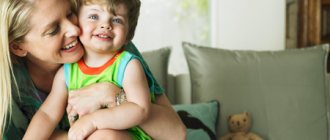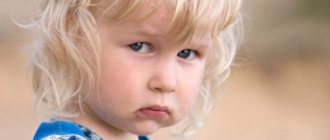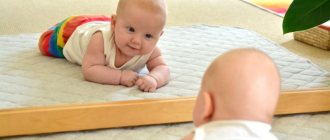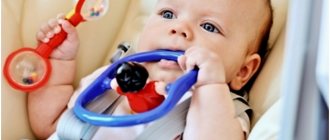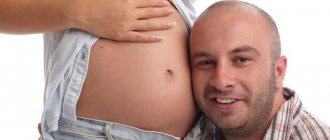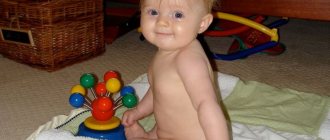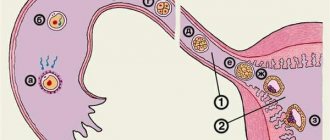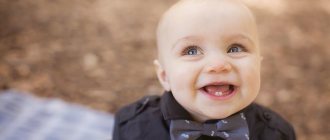How do the first words come about?
Every mother eagerly awaits her baby's first words. As a rule, all relatives are involved in the waiting process: mom, dad or grandma - which word will come first? Usually, the winner in this fight is the one who most often stands over the child’s crib, looks carefully into his eyes and clearly repeats: “pa-pa” or “ma-ma.” As a result, the child pronounces the cherished word, and the whole family celebrates the historical event! The child is bathed in applause, and he, satisfied, continues to babble the magical sounds that have caused so many positive emotions in adults. If you continue in the same spirit - look into the child’s eyes, clearly pronounce new words and just as emotionally rejoice at each new one - you will certainly be surprised at the dynamics of your baby’s speech development.
“Why exactly “dad”, “mom” and “baba”? The sounds that make up these words are classified as labiolabial and labiodental. They are formed with the help of lips and voice and are easiest for a child. In order for the baby to also easily develop front-lingual, mid-lingual and back-lingual sounds, add the “horse” exercise: click happily with him,” explains Olga Ivanova.
How and when do children start talking?
A child begins to communicate from birth using a cry - putting emotions into it. This is how he attracts attention to himself and expresses his demands. You need to start teaching him to talk from this age, then it will be too late.
Reflex vocal reactions - first words
In the first months of life, pre-speech reactions are reflexive. They appear in normally developing children at the same time and do not depend on training.
Voice reactions include:
- bumming;
- pipe;
- babble
Humming appears by 1.5 months. It happens even in children who are deaf from birth. First, the child says ooo, aaaa, by 2–3 months agu, boo, zy, agu. At this age, you need to help him pronounce sounds. Talking to him, answering his call.
The vocal response of the pipe appears in children at 4 months. Expressed in sounds - al-le-e-ly-agy-ay. The child pronounces such melodious syllables until the age of 7–8 months.
After the pipe the child begins to babble. Pronounces frequently repeated syllables ba-ba, mom, yes-da-da, accompanying speech with rhythmic movements. During this period, freedom of action is very important for the child.
After conducting many experiments, scientists have proven that those children who can move freely begin to talk earlier, better.
At the age of 8.5 - 9 months, modulated babbling appears. Mom and dad start calling their parents. The child repeats syllables with different intonations and if you ask him who it is, he confidently calls mom, dad,
Congenital reactions include manifestations of onomatopoeia in children from 2 to 7 months. Humming, babbling and playing the pipe are games. If you start talking to your baby and pronouncing sounds, he tries to repeat after the adults. This game brings him pleasure.
It is important to know! The baby gurgles and babbles when he is in comfortable conditions. He is warm, dry and full. He is especially interested in repeating sounds after adults. But in order for him to begin to develop correct articulation, the child needs to see the facial expressions of a speaking adult. Mom needs to look at him when talking to him. In addition, the room should be quiet.
In a baby in a noisy environment, all vocal reactions develop with a great delay.
What is active and passive vocabulary?
All the words that a child knows are his vocabulary (lexicon). Moreover, those words that the baby understands, but does not pronounce himself, belong to the passive dictionary. And those words and phrases that are constantly used in everyday speech are included in the active one.
Olga Ivanova: “For example, if you ask a one-year-old child “where is the cat?” and he points to the pet or the corresponding picture with his finger, which means the word “cat” is already in his passive dictionary. When he independently says “cat”, or “koska”, or any other sound that means a cat for a child, we can say that the word has become an active lexicon.”
It is worth noting that the passive vocabulary is always larger than the active one, even in an adult.
After all, each of us knows what society, quantum, molecule are, yet we almost never use these words in everyday speech.
How to calculate the volume of active and passive vocabulary?
Finding out the approximate number of words in a passive dictionary is easy. It is enough to ask the child to show a certain object, action, object (for example, a cat). If the child did everything correctly, then the word is counted in the passive dictionary.
Now let’s calculate the size of the active dictionary. What should you consider?
- Words that the child pronounces clearly: “give”, “mom”, “dad”.
- Onomatopoeia for animals and objects: car “beep-beep”, dog “woof-woof”.
- Reproduction of incomplete words: “baka” - dog.
- Words that are pronounced incorrectly, but the number of syllables and stress are correct: “patina” - machine.
- Words that are pronounced the same, but have different meanings (this is the norm up to 2.5 years): “ma” - mom, car, meow (each word is counted separately).
“To make it easier to count active vocabulary and clearly see the progress and dynamics of a child’s development, you need to keep a diary of speech development. Every month you can enter the words that your child has mastered. From 2.5-3 years old, keeping track of every word will be quite difficult due to the growing talkativeness. Then you can write down the baby’s funny sayings in your diary, which you will be happy to re-read in the future,” the speech therapist advises.
Speech development from birth to one year
From birth, a child is surrounded by many sounds. This is the rustling of leaves outside the window, sounds of nature, noise from household appliances, ticking clocks, various musical melodies and much more. But only the sounds of speech, out of all the surrounding noise, will subsequently be the main tool for mastering the ability to speak, transmit information, encourage action and perceive speech by ear. Speech development begins long before the first words, phrases and sentences, and speech is one of the important functions in the development of a harmonious personality.
Currently, expectant parents have many opportunities to prepare for the birth of their baby. To undergo an examination while planning a pregnancy and expecting a baby, reduce the risk of pathological formation and complications during the prenatal period of the child’s development.
Prenatal development period
This is a period that characterizes the birth of a new organism and all the processes necessary for normal functioning.
Why is it important for speech development?
The formation of lower nervous activity occurs, which is responsible for the activity of the central nervous system. This activity is aimed at regulating functions within the body, at uniting it into a single whole.
Already at the twelfth week of fetal development, unconditioned reflexes begin to form: the first sucking and breathing movements. And at 4-5 months, movement of the limbs is observed. Therefore, it is especially important for the expectant mother to take care of her health, proper nutrition and daily routine in the first months of pregnancy, because by taking care of herself, she first of all protects her unborn baby from unwanted dangerous factors.
The development of the cerebral cortex, in which speech zones are formed, begins from the 3rd month of intrauterine development.
After birth, the first signal system of the newborn (sense organs: vision, hearing, touch, smell, tactile perception) is in its infancy, signs of the second signal system (speech, its perception) are absent. However, the baby exhibits reflex reactions, which will be laid as the basis for further socialization and communicative behavior. Already from the first days of life, a reaction to a person’s face, in particular the mother’s, is manifested. If such a reaction is absent, this may be a reason to consult a neurologist. There is also a vocalization component aimed at communication. This is the first cry - a sound reaction indicating discomfort, calling for the satisfaction of basic needs.
In the first year of a child’s life, parents have questions about the stages of development of physiological abilities. No less important is psycho-speech development. Knowledge of the features of the development of higher nervous activity in young children is one of the most important conditions for the effective organization of the process of raising and educating a child.
Let's consider the preparatory pre-speech period, which precedes the first words and phrases, and is an important foundation for the formation of speech processes.
Reflex scream
From the moment of birth, the child exhibits vocal reactions that are far from the sounds of human speech. These manifestations are important for the coordination of the respiratory, articulatory and vocal parts of the speech apparatus.
A baby's cry is a defensive response to physical discomfort from a physiological point of view. Screaming is one of the body's physical reactions as part of the self-regulation mechanism. It is impossible to isolate individual sounds and break them down into their components.
The vocalizations of a newborn are unusually variable, differing in nature. No two children scream the same way. The production of sound is directly related to the work of the respiratory diaphragm; the vocal cords are not involved in the formation of vocalizations. The glottis functions differently when the diaphragm operates: it is either spasmodically compressed or wide open. A cry creates the preconditions for the appearance of speech sounds in the future, similar to the formation of vowels or consonants. But by analyzing them, it can be revealed that vocalizations are structureless, like the sound signals of animals and have nothing to do with vowels or consonants.
The stage of reflex screaming and crying is important for the formation of the main speech departments, since it prepares the ground for the subsequent development of intonation, voice timbre, and activates the articulatory apparatus.
The duration of this stage is about two months. The researchers' data revealed interesting facts about the manifestation of vocalizations in infants raised in various conditions: family, child's home. Studies have shown that from the 8th week of life, a child’s crying has differences; the frequency and nature of vocalizations are influenced by breastfeeding, the mother’s reaction to a cry, the sleep patterns of children, and wearing in a sling. There is a decrease in the total number of cries in children who receive timely care and are placed in the necessary conditions.
Two weeks after birth, the baby begins to adapt more and more to the conditions of the surrounding world, the child reacts to the voice of the speaker. He can listen, stop screaming during a melodic lullaby, and turn his head in the direction of speech. Then there is a reaction to the speaker's intonation.
The time comes for the next stage of speech development.
Humming and hooting
This stage can be observed in different children from two to five months. Humming, like screaming and crying, is the essence of the implementation of the hereditary program for the development of voice in infants. They do not involve feedback and appear even in children who are deaf and mute from birth. The humming of children resembles the cooing of a dove and is a monotonous vocalization, phonation of the pre-syllable type. Humming manifests itself in the reproduction of sound complexes, short sound reactions, such as: agu, uh-huh, ubu, ebn, ebm... Such sound complexes appear when a child expresses positive emotions. The baby gurgles only when he is in the most comfortable state. Buzzing develops against the background of genetic prerequisites associated with reflexes of breathing, sucking and swallowing and plays the role of training the speech apparatus in the development of speech.
During this period, screaming continues to function in parallel with hooting and humming. It transforms into screams and crying. In this case, it is an expression of negative emotions. In situations where it is necessary to express dissatisfaction with negative contact with the outside world, crying and screaming are realized. This could be fear, pain, or uncomfortable temperature conditions.
The baby develops and discovers other interesting vocal possibilities.
Babbling
This period is observed between 4 and 7 months. The child produces syllable series that are similar to words, but do not carry meaning, for example, baba, dada, gaga, mama. The baby can pronounce sounds that are unusual for human speech, various “clicking”, “gurgling”, as well as sounds of a wide variety of languages of the world. The babbling stage is an evolution of the imitation reflex. Here echolalia takes place - imitative sounds of a child, articulated unconsciously. At the same time, the baby can imitate himself, this phenomenon is called autoecholalia. During babbling, the baby’s central nervous system, in addition to auto-auditory signals, receives a complex of kinesthetic signals when the muscles of the articulatory apparatus move. The combination of kinesthetic and auto-auditory stimuli is the basis for the emergence of speech, and “primary speech” sound complexes appear in the central nervous system. When their own kinesthetic-auditory complexes are formed, the baby recognizes them in the speech of adults and intensively repeats them on an imitative basis. If a child has not articulated any sound complexes, they do not remain in his speech base; accordingly, the baby does not hear them in the speech of adults and does not repeat them. When babbling occurs, the phenomenon of echopraxia also appears, in which the child, thanks to vision, adopts the articulation of adults.
With subsequent speech practice, individual environmental sounds are distinguished and remain close to speech sounds. By the six-month mark, the baby has introduced the phonetic features of his native language. American scientists have established this fact in studies of the babbling of children in English-speaking and Asian countries. The experiment was presented at an American educational institution, where Chinese and American students were asked to distinguish the babble of their countrymen.
The difference from the previous stage is the work of not only the articulatory apparatus, but also the auditory analyzer. The child repeats syllabic formations, or syllables, since echolalia in the babbling stage is reproduced at the syllable level.
Taking similar syllabic constructions for words, adults would like to think that the baby associates them with close relatives: mom, dad, woman, but similar syllabic structures are found in different languages and differ in meaning.
Babbling occurs due to the interconnected work of the speech motor, visual and auditory analyzers. Therefore, the most significant role is played by hearing, which allows the child to differentiate the surrounding speech and compare it with his own on an unconscious level. Parents need to carefully monitor the development of the child’s hearing and vision organs at this moment, since the lack of their functioning can lead to irreversible or difficult to eliminate defects in speech development.
In the future, as the baby develops, he gradually adopts elements of speech, such as intonation, rhythm, and tempo.
A child’s speech activity at 8-9 months allows him to imitate unfamiliar sounds. If you ask a baby where mom or dad is, he is already able to point to them, and also reacts to his own name. The child pronounces the syllables pa-pa, ba-ba, ma-ma, imitating adults, but in a real life situation he does not yet associate them with images when interacting with others.
By nine to eleven months, the baby can have the names of several objects in his passive dictionary, reacts to his name, understands words associated with routine moments, and gradually his activities become regulated by adults.
By the age of 1, the first conscious words appear, and these do not necessarily have to be complete and correctly formed forms of words. It can be: “bi-bi”, “ko-ko”, “mu”. The baby can say: “Mom and Dad.” The main thing is that the baby has a sound representation of any object, action, situation or natural phenomenon. And in subsequent speech experience, with normal development, a vocabulary is formed, both passive (what the child understands) and active (what he reproduces himself). Let's look at the table at what age a child begins to speak and how vocabulary changes every month from one to three years.
How many words should a child have in his active vocabulary?
The norms for the formation of the active vocabulary of a child of preschool and primary school age are as follows:
Thus, if a child normally pronounces no more than 10 words per year, then a child’s vocabulary at 3 years old is already about 1000 words. The vocabulary of a 5-year-old child is already about 2000 words, and the vocabulary of a 6-year-old child is about 3500 words. Don't panic if you suddenly find that your child is speaking fewer words than normal. Each child is individual and develops at his own pace. There are children who begin to speak closer to 2 years, but understand everything already at 1-1.5 years.
If you still have doubts or questions about your baby’s development, for your own peace of mind, consult a specialist. Good dynamics are provided by the inclusion of fun games to develop vocabulary, as well as finger exercises and palm massage. Positive emotions play a very important role: going to the zoo, water park and spending creative time together with parents.
Why do children start talking late?
In children, the cause of speech development delay (SDD) can be:
- immaturity of the sensorimotor sphere;
- wrong upbringing.
If a child has a developmental disorder associated with imperfect functioning of the sensorimotor sphere (diseases, birth injuries), then correction is very difficult . In this case, only specialists (neurologist, psychologist, psychiatrist, speech therapist) can help.
When raising their baby, parents very often make mistakes that lead to developmental disorders.
The most common:
- lack of motivation;
- persistent learning;
- excess of emotions;
- lack of freedom of movement.
ZRD can be observed not only in children with whom their parents did not work. Very often the cause is overprotection. When parents, anticipating the desires of their baby, immediately give him the required thing, he just has to point his finger. In this case, the child has no motivation to develop speech. Why talk if it’s enough to just show and cry.
Very often, when teaching their child, parents demand that a word be repeated. But if the baby doesn’t want to, he begins to be silent, capricious, adults get angry at him, shout, or demand that he pronounce the word correctly.
This will not help the child; he will develop a dislike for spoken language. In addition, forcing a child to repeat any word is useless. Children remember better while playing.
The mistake of excessive emotionality occurs when the child said a word, the parents were happy and laughed. When he said it again, he did not understand the meaning of the word, did not connect the name and the subject. For him, it’s just a set of letters that evoked positive emotions in him and his parents. Children remember only those words whose meaning they understand.
Oddly enough, the lack of freedom of movement plays a significant role for the ZRR. Motor and speech activity are closely related, and this is due to the physiology of the brain. It has been noticed that children who are more active begin to talk faster. The development of fine motor skills contributes not only to the formation of speech skills, but also to learning to read and write.
Interesting experiment
The experiment was conducted with children aged 1 – 1.3 years. We created two groups. In the first group, they were constantly shown the same book, repeating the word “Book” 500 times. In another group they performed actions with this book. They said, “Give me a book,” “Take a book.” In the second case, the word “Book” was used 300 times.
Then, in the first group, various books and toys were laid out, placing between them the book that was shown. After which the experimenters asked the children to give them a book. The children immediately did it correctly, giving exactly the book that was shown to them. But when they were asked to give them another book, the children were at a loss and were given various toys. In the second group, children, after they were asked to give more books, began to give other books.
Conclusion : By manipulating with various objects, children not only remember the name better, but begin to generalize concepts.
Where can I get new words?
This, of course, is communication with parents and other close adults, and then added communication with other children. Interesting games and activities are also important - by expanding our horizons, we expand our vocabulary. What does it mean? At a very young age, every new sensation is recorded by a newly created neural connection in the baby's brain. Over time, everything that he has already learned and will snatch from the world around him in large quantities will begin to be reflected in words. Family traditions and holidays, walks and fairy tales.
“Everything around can become a source of enrichment for a growing person’s vocabulary. The main condition here is that the parent explains, names and shows. And in the future, he answered numerous questions,” explains Olga.
New sensations
Firstly, everything is tactile. Finger paints and various surfaces. Pet fur and rough tongues, sea and sand, pebbles and acorns, spruce branches and food. Plasticine and constructor. This is an inexhaustible source. And also sounds, smells and everything, everything, everything: music and new songs, for example, lullabies. The tastes of food and the smells of flowers - all this gives rise to new connections, new thoughts and requires words, stimulating the child.
Books, stories and games
Parents who read fairy tales and poems, invent nursery rhymes and sing songs are very helpful parents. Enthusiastic grandmothers, aunts, and older brothers and sisters also get involved. It is advisable to choose poems that are age-appropriate, and books with bright and clear pictures.
Travel and dating
Even if the baby just looks at everything and gurgles, new places and people will still awaken the dormant spirit of the explorer in him. The main thing on such trips is to tell and show the child everything, to let them touch what is interesting. And don’t be upset if a brick fence arouses more enthusiasm than a local landmark.
Brothers and sisters
In a large family, younger children usually speak better and start talking earlier because they often interact with older brothers and sisters.
Emotions
Find something that your child likes. A dog, a kettle and a slow cooker with lights, a pair of mom’s rubber boots - if a person is delighted, then you’re doing everything right. And it’s not far from the storm of emotions to its verbal expression.
How to develop baby babble?
- The main condition for the timely development of speech is communication. Conversation between mother and baby helps develop baby’s babbling and oral speech skills. The more you talk to a young polyglot, the faster he will speak. Talk about what is happening around you, comment on every action. Some parents do not understand why communicate with a silent toddler. In fact, he remembers everything, and then gradually “produces” the embedded program.
- Motor skills are the key to successful development of speech skills. Show your baby objects of different shapes, sizes, and feel. From 10 months, it is recommended to conduct classes with cereals, balls, and small toys. Playing with water is useful.
- It is necessary to offer the baby different-sounding things. These could be rattles, a children's xylophone, a drum, songs. Turn on the music and dance together to the rhythm. Such movements help to learn to separate sounds into individual syllables.
Is learning languages good for speech?
Early learning of languages helps the development of a child’s speech if this process brings joy to parents and the baby. Therefore, you need to switch to the foreign language that you like best and know best.
Bilingual children begin to speak earlier from birth if both parents actively communicate with them.
“I often compare learning a second language to learning to swim,” Olga explains. If a child begins to master this activity at 3–4 months, then by the age of three he will already be able to swim perfectly independently. Then you can start teaching him how to ski, say. And if you start swimming at the age of three, then, of course, this process will take much longer, and parallel training in different sports can cause certain difficulties. It’s the same with languages.”
Normal or not?
In the dialogues between parents, a note of boasting periodically slips through. “My son said “dad” at 6 months”, “And we’re already chatting with all our might” - who hasn’t heard such statements? Hearing something like this can make you doubt your child’s normality. But you need to remember two points:
- Every baby is unique. The norms of speech development are quite vague and allow the appearance of the first words in the interval from 8 months to one and a half years. Typically, children know 3-4 simple words per year and understand the words “give” and “go.”
- Mothers love to exaggerate the merits of their children, passing off what they want as the real thing.
Of course, there are times when you should really worry. For example, if a one-year-old child does not understand requests, does not listen to music, and does not respond to calls to him. In the situations described, you should not panic, but consult a doctor for professional diagnosis and possible correction.
Balance of active and passive vocabulary, or why develop speech?
A passive dictionary will always be larger in volume than an active one. At the same time, we should strive to achieve a balance between dictionaries, that is, try to use as many words as possible that we know in everyday speech. And teach this to our children. For what?
In modern society, people who can speak well and interestingly, with developed oratory skills, are valued. The ability to express one’s thoughts clearly and beautifully, captivate the audience, and win the interlocutor to one’s side will help the child in school, in communicating with peers, and throughout life. In addition, an increase in vocabulary entails the development of intelligence, memory, attention, imagination and perception.
A child with a rich vocabulary communicates more easily with adults and other children, and accordingly, adapts better in society. It is easier for such children to learn poetry, solve logical problems, create, and, in general, realize themselves.
What to do if the child does not speak? Read about the signs that should alert parents.
Share your story: when did your child start talking and what was his first word?
- share with your friends!
Experts: Olga Ivanova
